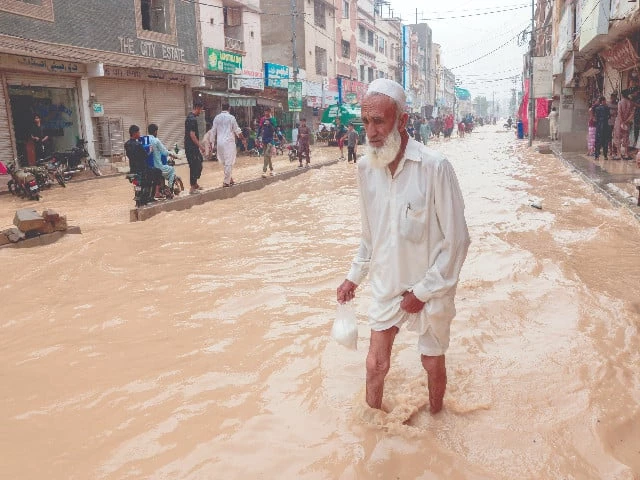Lahore:
Southern Punjab faces aggravate flooding emergency when rivers overflow and dams collapse and threaten to displace tens of thousands of more residents.
In the cosmopolitan city of Karachi, streets and houses in low -lying areas were flooded on Wednesday when Metropolis endured a third consecutive day of heavy monsoon rains, with rivers that were transferred, and rescue team that changed hundreds of residents to safety.
Punjab Disaster Management Authority (PDMA) has directed urgent evacuations from flood -fought districts, including Muzaffargarh, Lodhran, Rajanpur, Liaqatpur and Rahim Yar Khan, emphasizing that residents of river beds must be moved to safe areas without delay.
Chenab has risen to dangerous levels in Multan, where water crossed the 394.5-foot mark, forced mass evacuations and interferes with daily life.
Floodwaters entered villages including Basti Gagran Kachor, Mirza Pur and Hasan Kachor, leaving families stranded. Authorities redirected heavy traffic through Vehari and Khanewal as the key roads near Sher Shah and head Muhammadwala became uncertain.
Officials said that pressure is mounted on Sher Shah barrier and nearby dikes, where a controlled violation is being considered to relieve loads on dams.
If performed, more than 8,000 homes and 30,000 people could be affected. Warnings have already been issued for nearby settlements that encourage residents to move to aids.
Further downstream, India has released additional water in sutlej and intensified currents at Harike and Ferozepur.
On the head Panjnad reached 530,000 CUSERCS, classified as an “extremely high flood”. Pakistan’s Ministry of Water Resources has placed all departments in emergency.
In Muzaffargarh, 138 villages are submerged, affecting over 135,000 people. Rangpur reported an additional 50,000 displaced after 28 villages were flooded.
In Lodhran, violations left several communities underwater, while eight people in Alipur were swept away; Three were confirmed dead and five remain missing. Bahawalpur officials said that 150,000 inhabitants have been affected by rising waters in 98 locations.
Authorities fear that the crisis could be worsened in Jalalpur Pirwala, where 500,000 CuseCS released from the main trimmu increased downstream.
Emergency measurements are in place for the next 24 hours as thousands continue to escape from low -lying areas. Local officials said that more than 235,000 people and 180,000 livestock have been moved to safer land.
Provincial Disaster Management Authority (PDMA) reported that 2.1 million people have already been displaced over Punjab this monsoon, with almost two million Acres agricultural land submerged. Cotton, maize and sesame crops are wiped out in several districts and compound financial losses.
Public Health Cusing Also increases. The Punjab-Health Department said that more than 158,000 flooded people have had diseases, including respiratory tract infections, skin disorders, diarrhea and eye infections.
Snakebites and dog bites are also reported in relief. In Arifwala, stagnant water has also triggered outbreaks of waterborne diseases.
The provincial government has deployed more than 300 boats, 400 inflatable fleets and thousands of life jackets for Multan, Muzaffarh, Bahawalpur, Lodhran and Rahim Yar Khan. The Army and the rescue 1122 help with evacuations and efforts to connect violations.
According to the National Disaster Management Authority, Punjab has only registered 246 deaths this season, while nationwide toll stands at 929 with more than 1,000 wounded.
Floodwaters have now pushed into Sindh, where Indus, Sutlej and Chenab continue to rise. At Guddu Barrage, the flow of the flow exceeded 500,000 CUSERCS Wednesday with warnings that an even higher wave of flood could arrive within 12 hours.
SUKKUR BARRAGE recorded more than 440,000 CUSCCS Upstream as all gates were opened to ease the pressure.
Despite ongoing relief, villagers in Bhawana, Ahmedspur Sial, Uch Sharif and Kabirwala remain cut off and appeal to urgent rescue.
Officials warn that in the coming days will be crucial. With influx that continues from India and upstream barriers under strain, southern Punjab and Sindh remain on high alarm for what experts call one of the most serious flooding situations in recent memory.



